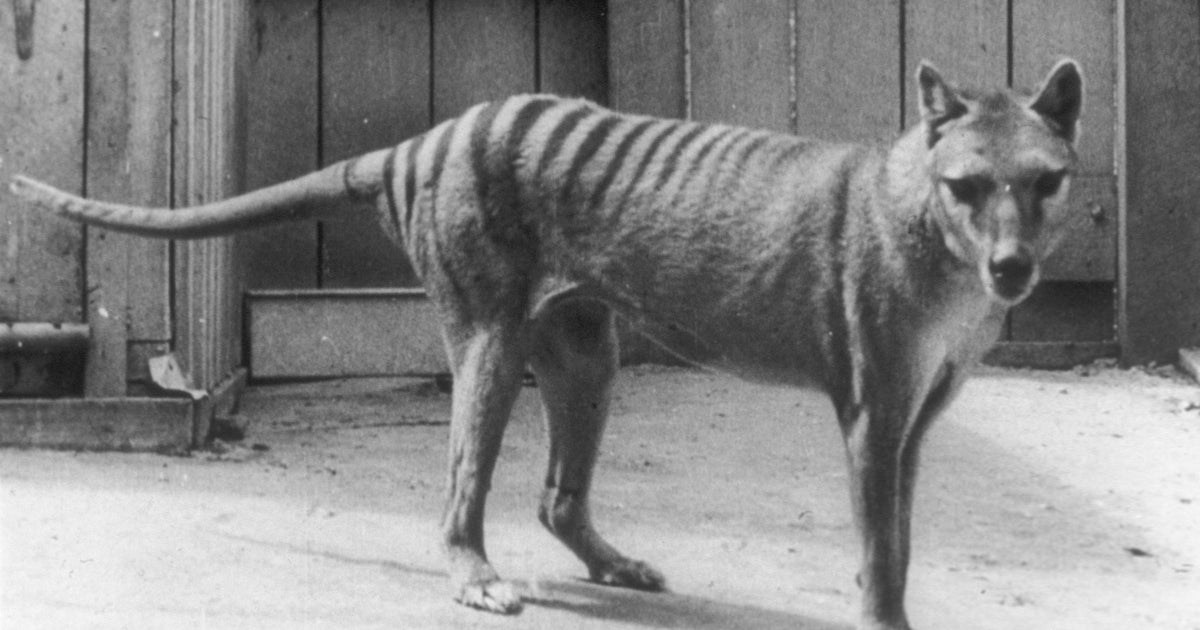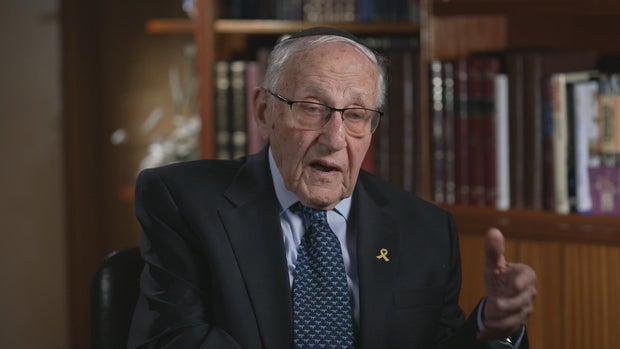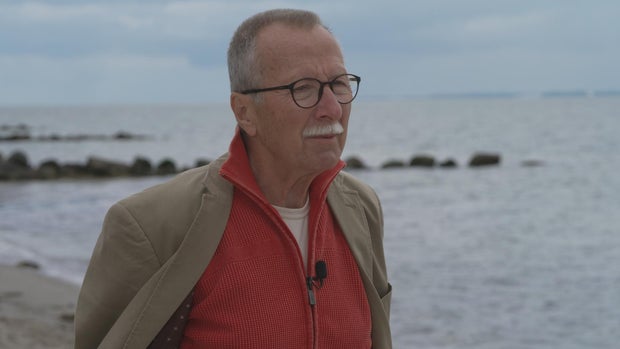CBS News
Scientists say they’ve made a breakthrough in efforts to bring back the extinct Tasmanian tiger

It’s been decades since Australia’s thylacine, known as the Tasmanian tiger, was declared extinct and scientists say they’ve made a breakthrough as they research ways to bring back the carnivore.
Colossal Biosciences in a Thursday press release said its reconstructed thylacine genome is about 99.9% complete, with 45 gaps that they’ll work to close through additional sequencing in the coming months. The company also isolated long RNA molecules from a 110-year-old preserved head, which was skinned and kept in ethanol.
“The thylacine samples used for our new reference genome are among the best preserved ancient specimens my team has worked with,” said Beth Shapiro, Colossal’s chief science officer and the director of the UCSC Paleogenomics Lab, where the samples were processed. “It’s rare to have a sample that allows you to push the envelope in ancient DNA methods to such an extent.”
Efforts to bring back the Tasmanian tiger
The preservation of a complete Tasmanian tiger head meant that scientists could study RNA samples from several important tissue areas, including the tongue, nasal cavity, brain and eye. It will allow researchers to determine what a thylacine could taste and smell, along with what type of vision it had and how its brain worked, according to Andrew Park, a member of Colossal’s Scientific Advisory Board and a researcher at the University of Melbourne’s TIGRR Lab.
“We’re getting closer every day to being able to place the thylacine back into the ecosystem – which of course is a major conservation benefit as well,” Pask said.
Pask, speaking with 60 Minutes earlier this year, said researchers were working with the closest living relative of the Tasmanian tiger — a small marsupial called the fat-tailed dunnart — as a way to bring the animal back.
“But that little dunnart is a ferocious carnivore, even though it’s very, very small,” Pask said. “And it’s a very good surrogate for us to be able to do all of this editing in.”
Scientists have been comparing the DNA of the dunnart and the thylacine, Pask told 60 Minutes. From there, it’s a matter of going in and editing the DNA to turn a fat-tailed dunnart cell into a thylacine cell.
Colossal Biosciences on Thursday said it had edited more than 300 unique genetic changes into a dunnart cell, making it “the most edited animal cell to date.”
“We are really pushing forward the frontier of de-extinction technologies,” Pask said, “from innovative ways of finding the regions of the genome driving evolution to novel methods to determine gene function. We are in the best place ever to rebuild this species using the most thorough genome resources and the best informed experiments to determine function.”
Efforts aiding the revival of the Tasmanian tiger are not confined to Australia. Last year, scientists recovered and sequenced RNA from a 130-year-old Tasmanian tiger specimen preserved at room temperature in Sweden’s Museum of Natural History.
How the Tasmanian tiger died off
Thylacines roamed Tasmania for thousands of years. Despite the Tasmanian tiger moniker, the carnivores were marsupials, like kangaroos, koalas and Tasmanian devils.
The local government in the late 1800s paid out bounties to hunters presenting carcasses of Tasmanian tigers because the animals had been eating farmers’ sheep, 60 Minutes previously reported. By the mid-1930s, the Tasmanian tiger population had dwindled to a single thylacine at the Beaumaris Zoo in Hobart, Tasmania’s capital. It died there in 1936.
Australia has similarly allowed the culling of Kangaroos, approving the deaths of thousands of kangaroos over the years. Officials have said the kangaroo population was eating through grassy habitats of endangered species. Officials have also warned in the past that there isn’t enough food available to sustain large kangaroo populations.
CBS News
Last Kmart store closes down

Watch CBS News
Be the first to know
Get browser notifications for breaking news, live events, and exclusive reporting.
CBS News
7 killed in Georgia dock collapse

Watch CBS News
Be the first to know
Get browser notifications for breaking news, live events, and exclusive reporting.
CBS News
Holocaust survivors who witnessed the Cap Arcona bombing share their stories | 60 Minutes

During the Holocaust, Manfred Goldberg survived confinement in the Riga, Latvia ghetto and four concentration camps before he witnessed a bombing in Germany that took the lives of thousands of prisoners.
On May 3, 1945, just days before the end of World War II in Europe, British Royal Air Force planes mistakenly attacked the Cap Arcona ocean liner in Lübeck Bay in the Baltic Sea. The ship was crammed with thousands of concentration camp prisoners.
As the planes struck, Goldberg was at a nearby German naval base, lined up under SS guard with other prisoners.
“And it is while we stood there that we witnessed bombers and fighter planes coming along,” Goldberg said.
He remembers seeing the planes drop ordnance and hearing detonations.
“There were some pretty powerful explosions, and there were quite a few,” Goldberg said.
Before the war
Before World War II, the Cap Arcona was a German cruise ship for the well-to-do. For more than a decade after its 1927 launch, the ocean liner transported well-heeled passengers from Europe to South America in just two weeks. The ship had many luxuries, including a tennis court, a heated swimming pool and a restaurant with an ocean view, historian Bill Niven said.
The cruise ship traversed the Atlantic dozens of times. On one of its last trips before the war, the ocean liner carried some German Jewish passengers who had bought tickets to safety in South America.
In 1939, as German troops invaded Poland, the Nazis commandeered the Cap Arcona. It was repurposed into a floating barracks in the Baltic.
Who were the prisoners sent to the Cap Arcona
In 1945, as Allied forces closed in, the rusted and battered Cap Arcona was repositioned to the Nazi holdout at Lübeck Bay. At the same time, SS Chief Heinrich Himmler ordered the evacuation of concentration camps.
“I think the main concern was to get rid of evidence because prisoners are evidence,” Niven said. “They can talk. They can tell. They can speak to those atrocities that were committed by the Nazis. So getting rid of the evidence meant getting rid of human beings.”
Thousands of prisoners — Jews, Americans, Greeks and Italians among them — were sent to Lübeck Bay. The Cap Arcona arrived on April 14, 1945, two weeks before Nazi leader Adolf Hitler killed himself and three weeks before the end of the war in Europe. It was anchored about 2 miles offshore. With its engines barely running and little in the way of food and water, the once playground for the rich and famous was about to become a prisoner ship.
With nowhere to hold the amassed prisoners, SS guards jammed more than 4,000 of them onto the Cap Arcona.
“And one must remember this is a ship that’s meant for 1,500 people,” Niven said. “It’s not meant for 4 to 5,000 prisoners.”
Willi Neurath, a political prisoner, was among those forced on to the Cap Arcona. Neurath was not Jewish but he actively opposed the Nazi regime and was arrested for distributing anti-fascist fliers. He spent time in Buchenwald, and then the Neuengamme camp near Hamburg, before his Nazi captors sent him to Lübeck Bay.
60 Minutes
Jewish concentration camp prisoners George Schwab, Manfred Goldberg, and his mother Rosa were sent to Lübeck Bay from the Stutthof Camp in Nazi-occupied Poland.
Goldberg, now 94, was just 11 when the Nazis forcibly removed him and other Jews from his hometown of Kassel, in central Germany.
Schwab, now 92, was only 9 when German soldiers invaded his hometown of Liepāja, Latvia. The Nazis killed his father, a prominent physician, after he tried to protect other Jews in town.
The perilous journey to the Cap Arcona
From the Stutthof camp, Schwab and the Golbergs were put on barges. Packed with a thousand prisoners each, the barges were towed by tugboat for days until they reached Lübeck Bay.
Schwab remembers his time on the barge as “hell on Earth.” There were no bathrooms and hardly any food.
“You could hardly sit, you can certainly not sleep,” he said
60 Minutes
Many on the barges did not survive the journey to Lübeck Bay. Once there, the SS guards uncoupled the tugboats, leaving the prisoners adrift.
George Schwab and Manfred Goldberg said that on the barges were prisoners of war, who were better fed and better treated than the concentration camp survivors, and seized the opportunity.
Goldberg said they pried floorboards loose and turned them into makeshift oars. Norwegian prisoners aboard Schwab’s barge used blankets to make sails, taking advantage of the wind.
Once the barges reached shore, Schwab and the Goldbergs found the strength to climb out, only to be intercepted by the SS and German troops, who shot and killed many prisoners on the spot.
“And we felt practically certain that we would be shot next,” Goldberg said. “But instead they lined us up into a column.”
The Goldbergs and Schwab were taken to the nearby naval base, where they witnessed bombers fly overhead.
Why the Royal Air Force bombed the ship
The Cap Arcona was hit at approximately 3 p.m. In a hard-to-believe turn of events, the attackers were British Typhoons, part of the Allied forces moving in to finish off the Nazis. They’d come to liberate prisoners and ended up mistakenly killing thousands of them.
“You can imagine the panic and the horror that broke out when the bombs hit the ship,” Niven said, “especially for those concentration camp prisoners who were on the very lower decks of the ship. And they were unable to get up– to the top because of the flames.”
Sebastian Cox is chief historian for the Royal Air Force. He says the attack is “quite probably” the worst case of friendly fire in RAF history. He blames the incident on the fog of war.
“[The Allies believed] there was going to be an attempt to flee by certain Nazi elements across the Baltic to Norway,” Cox said, “and essentially continue the war.”
Cox said the pilots had no idea that concentration camp survivors were on the Cap Arcona. But other members of the British military did know, said Daniel Long, who wrote his Ph.D. history thesis on the Cap Arcona attack.
Long showed 60 Minutes what he said is the only official investigation into the tragic bombing. The report was completed in 1945 and is now held at the British National Archives in London. Shortly after Germany surrendered, a British war crimes investigator interviewed the intelligence officer for the squadrons that attacked the Cap Arcona and other ships in the bay.
60 Minutes
Long said that according to the report, the intelligence officer admitted a message was received on May 2, 1945 that the ships had been loaded with concentration camp prisoners.
That information, which came in the day before the Cap Arcona was attacked, never made it to the pilots, Long said. The report does not say why the intelligence officer failed to inform the pilots but it blamed Royal Air Force personnel for the error and called for further inquiry.
Cox said he is not aware of any follow-up investigation ever taking place, but he said it would “in many respects, be a little pointless.”
“We know what happened. The RAF made a mistake. An individual made a very tragic mistake,” Cox said. “And we know the consequences.”
The Cap Arcona’s survivors
About 7,000 prisoners perished when the Cap Arcona and a smaller cargo ship were bombed in Lübeck Bay. Of the more than 4,000 prisoners on the Cap Arcona, only about 400 survived, including Neurath. He couldn’t swim, so he didn’t jump into the water to escape the burning ship, his son Neurath-Wilson said, adding: “Prisoners who jumped into the water were shot by the SS.”
When the British realized their mistake, they dispatched rescuers who plucked Neurath and others from the listing deck of the Cap Arcona and took them to shore. Neurath-Wilson’s mother Eva was working at the nearby naval base. When she saw the bombing, she was drawn to the beach.
Neurath-Wilson said, “She had only one hope: To know, ‘Where is my husband? Is he still living? And maybe my husband is on the ship.'”
60 Minutes
On the beach, Neurath-Wilson said Eva didn’t recognize her husband, until he called out “Muppel,” his nickname for her. The pair reunited and Neurath-Wilson now shares his parents’ story.
Schwab pulled inspiration from the horror. A native of Latvia, he moved to New York, earned a Ph.D. in political science, and had an illustrious career as an academic and peace broker. He was awarded Latvia’s highest state decoration for his work helping the country join NATO.
Goldberg and his mother settled in London. She passed away in 1961. Goldberg married and started a business and a family. In 2017, he returned to the Stutthof camp with the then-Duke and Duchess of Cambridge, William and Catherine. He has made it his life’s mission to share his story.
“I consider that part of my revenge on the Nazis. They wanted to exterminate us. And here we are, not only having survived,” Goldberg said. “We are now great-grandparents.”
The Cap Arcona lay half-sunken in Lübeck Bay for four years before being dismantled. But the story has lain beneath the surface, little known beyond the Baltic Coast. It’s now tradition on the third of May for families of victims and survivors to sail to the site where the ship was bombed. They want the world to remember.












